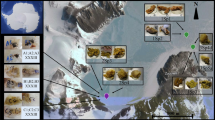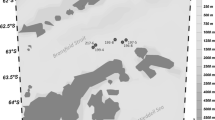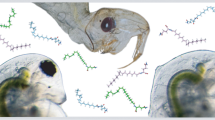Abstract.
Sponges are sessile filter feeders that are exposed to toxic compounds/xenobiotics and a huge number of diverse pro- and eukaryotic organisms occurring in the aqueous milieu. To cope with these threats, sponges have developed a variety of chemical and immunological defense systems. Among them are potent secondary metabolites or toxins. The demosponge Suberites domuncula contains the bioactive compound okadaic acid; concentrations of ≈50 ng/g (≈60 nM) of wet tissue have been quantified by LC/MS. In the present study, we sought to determine whether okadaic acid is beneficial for this sponge. Antibodies were raised against okadaic acid and used to localize this compound in situ. It could be demonstrated that the polyclonal antibodies/antiserum stained the sponge cells (endopinacocytes) which form the epithelium of the lacunae and the water channels. They also reacted with bacteria present in sponge tissue. Okadaic acid was found to augment the immune response of S. domuncula against the bacterial endotoxin lipopolysaccharide (LPS). If primmorphs, a special form of 3-D aggregates, are incubated with LPS at a concentration of 3 µg/ml, a reduction in the incorporation rate of [3H] phenylalanine is measured. In the presence of okadaic acid, this effect is measured already at a concentration of 1 µg/ml, suggesting that okadaic acid sensitizes this (immune) response. Okadaic acid is a known inhibitor of protein phosphatases which, as shown here, cause an increased phosphorylation of p38, a central kinase of the MAP kinase pathway; this may explain the sensitive response of the sponge cells to LPS. At higher concentrations, okadaic acid induces apoptosis, as was demonstrated here by a differential expression of the Bcl-2 homolog and the caspase gene. It is concluded that okadaic acid has two functions in the sponge; first, at low concentrations (<100 nM) a stimulation of the defense system against bacteria, and second, at concentrations above 500 nM, a differential effect on the pro-/anti-apoptotic genes.
Similar content being viewed by others
Author information
Authors and Affiliations
Additional information
Electronic Publication
Rights and permissions
About this article
Cite this article
Wiens, .M., Luckas, .B., Brümmer, .F. et al. Okadaic acid: a potential defense molecule for the sponge Suberites domuncula . Marine Biology 142, 213–223 (2003). https://doi.org/10.1007/s00227-002-0886-6
Received:
Accepted:
Issue Date:
DOI: https://doi.org/10.1007/s00227-002-0886-6




